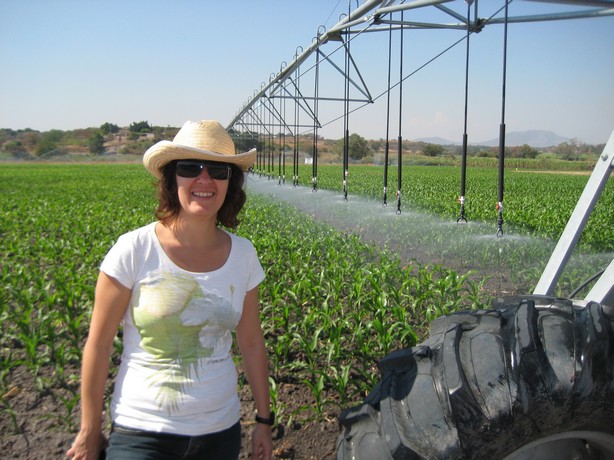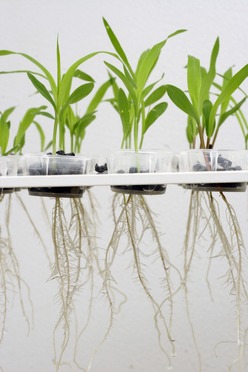Read how this cocktail blends in a comparative genomics crucible, where both family genes and crop genes come into play in Brazil. Nothing whatsoever to do with the World Cup. It’s all about a passionate love affair with plant science – specifically a quest for aluminium-resilient maize – spanning a decade-and-a-half, and still counting…
“I love the whole process of science; from identifying a problem, developing a method, conducting the experiments, analysing the data and evaluating the findings.” – Claudia Guimarães (pictured), Researcher at EMBRAPA Milho e Sorgo, Sete Lagoas, Brazil
I always enjoyed looking after the cattle and horses as well as planting and harvesting different crops.”
Forged on family farm, federal institute and foreign land
Claudia Guimarães is a plant molecular geneticist, with a pronounced passion for science. At the Federal University of Viçosa, Claudia studied agronomy because it provided a wide range of possibilities career-wise. She also believes her family’s farming background too had a part to play in her study and career choice. “My father has a farm in a small village 200 km north of Sete Lagoas. My whole family used to go there during our school holidays. I always enjoyed looking after the cattle and horses as well as planting and harvesting different crops.”
During her bachelor’s degrees, Claudia was increasingly drawn to plant genetics. She decided to pursue this field further and completed a Master’s degree in Genetics and Breeding, focusing on maize. She then completed a PhD in Comparative Genomics where she split her time between California and Brazil. “For my PhD, I got a scholarship from the Brazilian Council for Scientific and Technological Development which included international training in San Diego, California. During my PhD, I focused on comparative genomics for sugarcane, maize and sorghum, which involved genetic mapping and markers,” Claudia reveals.
Returning to Brazil after two years in California, Claudia joined the Brazilian Agricultural Research Corporation, commonly referred to as EMBRAPA (Empresa Brasileira de Pesquisa Agropecuária), where she has worked for the last 15 years, since 1999.

Preparing to put her shoulder to the wheel, literally? Claudia in a maize field at the International Maize and Wheat Improvement Center (CIMMYT), Tlaltizapan, Mexico, in January 2010.

Maize plantlets cultivated in nutrient solution, the methodology Claudia and her team use to evaluate aluminium tolerance.
Our next challenge is to develop specific markers for a wider marker-assisted selection of aluminium tolerance in maize.”
Long-term allies in aluminium tolerance
EMBRAPA first became involved with GCP through one of its foundation programmes headed by Leon Kochian and his former PhD student Jurandir Magalhães. “Jura has been a really close friend for a long time,” explains Claudia. “We went to university together and have ended up working together here at EMBRAPA. I was involved in Jura’s project, which sought to clone a sorghum aluminium-tolerance gene.”
This gene is called SbMATE. Claudia continues, “EMBRAPA had a long-term aluminium-tolerance programme on maize and sorghum, within which there was a QTL mapping project for aluminium tolerance in maize, in which we started to look for a similar gene as the sorghum team.”
[Editor’s note: QTL stands for quantitative trait locus or loci – gene loci where allelic variation is associated with variation in a quantitative trait. An allele is a variant (different version) of a gene, that leads to variation in a trait, eg different colour for hair and eyes in human beings.]
Working with Leon Kochian at Cornell University, USA, Claudia and her team were able to find an important aluminium-tolerance gene homologue (loosely meaning a relative or counterpart) to the sorghum SbMATE, which they named ZmMATE. This gene is responsible for a major aluminium tolerance QTL that improves yield in acidic soil in maize breeding lines and hybrids. (see why scientists work jointly on closely related cereals)
“Identifying and then validating ZmMATE as the primary aluminium tolerance QTL in maize was a great project,” says Claudia. “Our next challenge is to develop specific markers for a wider marker-assisted selection of aluminium tolerance in maize.”

March 2014. Photo 1: Rhyzobox containing two layers of Cerrado soil – a corrected top-soil and lower soils with 15 percent aluminium saturation. We can see that near-isogenic lines (NILs) introgressed with the aluminium-tolerance QTL (qALT6) that encompasses ZmMATE1 show deeper roots and longer secondary roots in acidic soils, whereas the roots of L53 are mainly confined in the corrected top soil. Photo 2: Maize ears, representing the improved yield stability in acidic soils of a NIL per se and crossed with L3. NILs have the genetic background of L53 introgressed with qALT6, the major aluminium-tolerance QTL.
…the students have really become my arms… helping me a lot with the experiments…
Giving and receiving: students step in, partners in print
Supervising students has become a larger part of Claudia’s life since becoming a member of the Genetics Graduate Programme at Universidade Federal de Minas Gerais, in 2004. Because of this, she credits the students for helping her with her research. “I don’t have as much time as I used to in the lab, so the students have really become my arms in that area, helping me a lot with the experiments,” Claudia reveals. “This isn’t to say that they don’t have to think about what they are doing. I encourage them to always be thinking about why they are doing an experiment and what the result means. At the end of the day, they need to know more about what they are doing than I do, so they can identify indiscretions and successes.”
Claudia says she is always preaching three simple instructions to her students – work hard, always continue to learn and like what you do. “The last instruction is particularly important because as a scientist you need to dedicate a lot of time to what you do, so it helps if you like it. If you don’t like it then it becomes frustrating and no fun at all. I don’t think of my work as a job, rather as a passion. I just enjoy it so much!”
Claudia’s passion is not just a matter of the heart but also of the head, expressing itself in print. Her latest publication reflects the most current results on maize aluminium tolerance, highlighting GCP support, partnerships within and beyond EMBRAPA embracing Cornell University and the Agricultural Research Services of the United States Department of Agriculture (USDA–ARS) , as well as the strong presence of students. Check it out
Links:
- Claudia’s maize project
- Comparative Genomics Research Initiative – Blogpost | Project | InfoCentre
SLIDES








